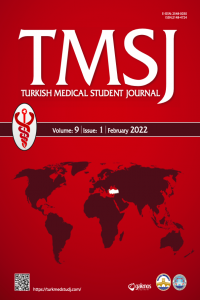THE INFLUENCE OF INTERCURRENT DISEASES ON THE COURSE OF HIV IN ASSOCIATION WITH ACTIVE TUBERCULOSIS
THE INFLUENCE OF INTERCURRENT DISEASES ON THE COURSE OF HIV IN ASSOCIATION WITH ACTIVE TUBERCULOSIS
Aims: We aimed to establish the features of the course of HIV in association with active tuberculosis in the presence of other secondary diseases and opportunistic infections. Methods: In this research, 155 HIV patients with active newly diagnosed tuberculosis and 76 diagnosed only with tuberculosis have been comprehensively immunologically examined. The HIV/Tuberculosis group was divided into 3 subgroups depending on the time of adherence of Tuberculosis to HIV infection. STATISTICA 6.0 was used for data analysis, and when the number of observations is less than 20, the Wilcoxon nonparametric method for independent populations or the dispersive analysis of Kruskal-Wallis was used. In addition, Mann-Whitney U test was used to compare two independent groups. Results: The number of CD4 + T-lymphocytes was lower compared with patients without secondary ailments. However, the level of serum concentration and spontaneous production of IL-4 and IFN-γ, as well as VL HIV was higher in the presence of other secondary diseases. Conclusion: In the presence of secondary diseases and opportunistic infections, the number of CD4 + T-lymphocytes was lower, and the level of serum concentration and spontaneous production of IL-4, IFN-γ and viral load was higher compared to patients without these ailments. In the case of secondary diseases and opportunistic infections, the frequency of death of patients was significantly higher than in their absence.
Keywords:
HIV, tuberculosis viral load, mortality, cytokines,
___
- 1. Van der Werf MJ, Yegorova OB, Chentsova N et al. Tuberculosis-HIV co-infection in Kiev City, Ukraine. Emerg Infect Dis 2006;12(5):766-8.
- 2. Vinnard C, Ravimohan S, Tamuhla Neo et al. Pyrazinamide clearance is impaired among HIV/tuberculosis patients with high levels of systemic immune activation. PLoS ONE 2017;12(11):e0187624.
- 3. Martinson NA, Hoffmann CJ, Chaisson ER. Epidemiology of Tuberculosis and HIV. Recent advances in understanding and responses. Proc Am Thorac Soc 2011;8(3):288–93.
- 4. U.S. Department of Health and Human Services. HIV and tuberculosis. 2018. Available from: URL: https://aidsinfo.nih.gov/understanding-hiv-aids/fact-sheets/26/90/hiv-and-tuberculosis--tb-.
- 5. Iakobchuk AV. Especially with engaging HIV, AIDS, tuberculosis. Health of the Nation 2007;3(4):76-82.
- 6. Machedi D. Principles of struggle against a HIV the associated tuberculosis. WHO/HIV/AIDS 2012;2:12.
- 7. Lapac SN. Statistical methods in medical biological studies using Excell. Morion 2000;320.
- 8. Murray JF, Mills J. Pulmonary infectious complications of human immunodeficiency virus infection. Part I. Am Rev Respir Dis 1990;141:1356-72.
- 9. Shafer RW, Chirgwin KD, Glatt AE et al. HIV prevalence, immunosuppression, and drug resistance in patients with tuberculosis in an area endemic for AIDS. AIDS 1991;5(4):399-405.
- 10. Braun MM, Badi N, Ryder RW et al. A retrospective cohort study of the risk of tuberculosis among women of childbearing age with HIV infection in Zaire. Am Rev Respir Dis 1991;143(3):501-4.
- ISSN: 2148-4724
- Başlangıç: 2014
- Yayıncı: Trakya Üniversitesi
Sayıdaki Diğer Makaleler
THE INFLUENCE OF INTERCURRENT DISEASES ON THE COURSE OF HIV IN ASSOCIATION WITH ACTIVE TUBERCULOSIS
Tetiana Kolotylo, Hennadii PETROCHENKOV, Orest GRİTSİUK
Ali Rıza AVUL, Büşra ÖZDEMİR, Gülay Durmuş ALTUN
AN INVESTIGATION ON THE ANTICANCER EFFECT OF SPIDER WEB IN HUMAN CERVICAL CELL LINE
Aslı Nur ÖZKAN, Oğuzhan DOĞANLAR
CAENORHABDITIS ELEGANS AND ANGIOGENESIS
İbrahim KILIÇÇALAN, Abdulbaki ERKOVAN, Emine ŞEN
EVALUATION OF MALNUTRITION STATUSES IN SYSTOLIC HEART FAILURE PATIENTS
İrmak İrem ÖZYİĞİT, Beliz KOÇYİĞİT, Begüm SÖYLEYİCİ, Fatih Mehmet UÇAR
SYSTEMIC CANNABIDIOL DOES NOT REDUCE COMPOUND 48/80-INDUCED ITCHING BEHAVIOR IN MICE
Hatice Demirel, Elif Baksın, Ece Önay Özgür, Ruhan Deniz Topuz, Ahmet ULUGÖL
